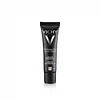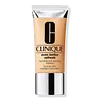Vichy Dermablend 3d Correction Foundation Versus Clinique Even Better Refresh Hydrating and Repairing Makeup
What's inside
What's inside
 Key Ingredients
Key Ingredients

 Benefits
Benefits

 Concerns
Concerns

 Ingredients Side-by-side
Ingredients Side-by-side

Water
Skin ConditioningDimethicone
EmollientGlycerin
HumectantSynthetic Fluorphlogopite
Hydroxyethyl Acrylate/Sodium Acryloyldimethyl Taurate Copolymer
Emulsion StabilisingDimethicone Crosspolymer
Emulsion StabilisingTriethanolamine
BufferingSalicylic Acid
MaskingAluminum Hydroxide
EmollientPhenoxyethanol
PreservativeDisodium Stearoyl Glutamate
CleansingEperua Falcata Bark Extract
Skin ProtectingTitanium Dioxide
Cosmetic ColorantCI 77491
Cosmetic ColorantCI 77492
Cosmetic ColorantCI 77499
Cosmetic ColorantWater, Dimethicone, Glycerin, Synthetic Fluorphlogopite, Hydroxyethyl Acrylate/Sodium Acryloyldimethyl Taurate Copolymer, Dimethicone Crosspolymer, Triethanolamine, Salicylic Acid, Aluminum Hydroxide, Phenoxyethanol, Disodium Stearoyl Glutamate, Eperua Falcata Bark Extract, Titanium Dioxide, CI 77491, CI 77492, CI 77499
Water
Skin ConditioningDimethicone
EmollientMethyl Trimethicone
Skin ConditioningTrimethylsiloxysilicate/Dimethiconol Crosspolymer
Butylene Glycol
HumectantPhenyl Trimethicone
Skin ConditioningNeopentyl Glycol Diheptanoate
EmollientNiacinamide
SmoothingHydroxyethyl Urea
HumectantPPG-12/Smdi Copolymer
EmollientLauryl PEG-9 Polydimethylsiloxyethyl Dimethicone
Skin ConditioningGlycerin
HumectantSodium Polyaspartate
HumectantPEG-10 Dimethicone
Skin ConditioningSigesbeckia Orientalis Extract
Skin ConditioningPolygonum Cuspidatum Root Extract
AntioxidantAcetyl Hexapeptide-8
HumectantSorbitol
HumectantIsopropyl Isostearate
EmollientPPG-15 Stearyl Ether
EmollientMicrococcus Lysate
Skin ConditioningResveratrol
AntioxidantPalmitoyl Hexapeptide-12
Skin ConditioningSalicylic Acid
MaskingCaffeine
Skin ConditioningPolysilicone-11
Sodium Chloride
MaskingTocopheryl Acetate
AntioxidantPolymethyl Methacrylate
Disteardimonium Hectorite
StabilisingDimethicone/PEG-10/15 Crosspolymer
Lecithin
EmollientTriethoxycaprylylsilane
Caprylyl Glycol
EmollientZinc Stearate
Cosmetic ColorantGlyceryl Polymethacrylate
Laureth-7
EmulsifyingTrehalose
HumectantTriethyl Citrate
MaskingSodium Hyaluronate
HumectantDimethicone Silylate
PEG-8
HumectantMagnesium Aluminum Silicate
AbsorbentMethicone
EmollientAlumina
AbrasiveSilica
AbrasivePropylene Glycol Caprylate
Skin ConditioningHexylene Glycol
EmulsifyingXanthan Gum
EmulsifyingDisodium EDTA
BHT
AntioxidantPotassium Sorbate
PreservativePhenoxyethanol
PreservativeMica
Cosmetic ColorantCI 77491
Cosmetic ColorantCI 77492
Cosmetic ColorantCI 77499
Cosmetic ColorantCI 77891
Cosmetic ColorantWater, Dimethicone, Methyl Trimethicone, Trimethylsiloxysilicate/Dimethiconol Crosspolymer, Butylene Glycol, Phenyl Trimethicone, Neopentyl Glycol Diheptanoate, Niacinamide, Hydroxyethyl Urea, PPG-12/Smdi Copolymer, Lauryl PEG-9 Polydimethylsiloxyethyl Dimethicone, Glycerin, Sodium Polyaspartate, PEG-10 Dimethicone, Sigesbeckia Orientalis Extract, Polygonum Cuspidatum Root Extract, Acetyl Hexapeptide-8, Sorbitol, Isopropyl Isostearate, PPG-15 Stearyl Ether, Micrococcus Lysate, Resveratrol, Palmitoyl Hexapeptide-12, Salicylic Acid, Caffeine, Polysilicone-11, Sodium Chloride, Tocopheryl Acetate, Polymethyl Methacrylate, Disteardimonium Hectorite, Dimethicone/PEG-10/15 Crosspolymer, Lecithin, Triethoxycaprylylsilane, Caprylyl Glycol, Zinc Stearate, Glyceryl Polymethacrylate, Laureth-7, Trehalose, Triethyl Citrate, Sodium Hyaluronate, Dimethicone Silylate, PEG-8, Magnesium Aluminum Silicate, Methicone, Alumina, Silica, Propylene Glycol Caprylate, Hexylene Glycol, Xanthan Gum, Disodium EDTA, BHT, Potassium Sorbate, Phenoxyethanol, Mica, CI 77491, CI 77492, CI 77499, CI 77891
Ingredients Explained
These ingredients are found in both products.
Ingredients higher up in an ingredient list are typically present in a larger amount.
Ci 77491 is also hydrated iron III oxide. It's sole purpose is to give a red/pink hue to products.
Iron III oxides are classified as inorganic chemicals for coloring.
Synthetically created Ci 77491 is considered safer than those naturally found. This is because the synthetically created version may contain less impurities. Iron oxides are generally non-toxic and non-allergenic.
Learn more about CI 77491Ci 77492 is also hydrated iron III oxide. It's sole purpose is to give a yellow hue to products.
Iron III oxides are classified as inorganic chemicals for coloring.
Synthetically created Ci 77492 is considered safer than those naturally found. This is because the synthetically created version may contain less impurities. Iron oxides are generally non-toxic and non-allergenic.
Learn more about CI 77492Ci 77499 is also hydrated iron III oxide. It is created from mixing red and black iron oxides. This helps give shades of darkness to a product.
Iron III oxides are classified as inorganic chemicals for coloring.
Dimethicone is a type of synthetic silicone created from natural materials such as quartz.
What it does:
Dimethicone comes in different viscosities:
Depending on the viscosity, dimethicone has different properties.
Ingredients lists don't always show which type is used, so we recommend reaching out to the brand if you have questions about the viscosity.
This ingredient is unlikely to cause irritation because it does not get absorbed into skin. However, people with silicone allergies should be careful about using this ingredient.
Note: Dimethicone may contribute to pilling. This is because it is not oil or water soluble, so pilling may occur when layered with products. When mixed with heavy oils in a formula, the outcome is also quite greasy.
Learn more about DimethiconeGlycerin is already naturally found in your skin. It helps moisturize and protect your skin.
A study from 2016 found glycerin to be more effective as a humectant than AHAs and hyaluronic acid.
As a humectant, it helps the skin stay hydrated by pulling moisture to your skin. The low molecular weight of glycerin allows it to pull moisture into the deeper layers of your skin.
Hydrated skin improves your skin barrier; Your skin barrier helps protect against irritants and bacteria.
Glycerin has also been found to have antimicrobial and antiviral properties. Due to these properties, glycerin is often used in wound and burn treatments.
In cosmetics, glycerin is usually derived from plants such as soybean or palm. However, it can also be sourced from animals, such as tallow or animal fat.
This ingredient is organic, colorless, odorless, and non-toxic.
Glycerin is the name for this ingredient in American English. British English uses Glycerol/Glycerine.
Learn more about GlycerinPhenoxyethanol is a preservative that has germicide, antimicrobial, and aromatic properties. Studies show that phenoxyethanol can prevent microbial growth. By itself, it has a scent that is similar to that of a rose.
It's often used in formulations along with Caprylyl Glycol to preserve the shelf life of products.
Salicylic Acid (also known as beta hydroxy acid or BHA) is a well-known ingredient for treating skin that struggles with acne and clogged pores. It exfoliates both the skin's surface and deep within the pores to help clear out buildup, control oil, and reduce inflammation.
Unlike AHAs (alpha hydroxy acids), salicylic acid is oil-soluble. This allows it to penetrate into pores which makes it especially effective for treating blackheads and preventing future breakouts.
Salicylic acid is also known for its soothing properties. It has a similar structure to aspirin and can calm inflamed or irritated skin, making it a good option for acne-prone skin that is also sensitive.
Concentrations of 0.5-2% are recognized by the U.S. FDA as an over-the-counter topical acne product.
It can cause irritation and/or dryness if one's skin already has a compromised moisture barrier, so it's best to focus on repairing that before introducing this ingredient into your routine.
While salicylic acid does not increase sun sensitivity, it’s still important to wear sunscreen daily to protect your skin.
If you are looking for the ingredient called BHA or Butylated Hydroxyanisole, click here.
Learn more about Salicylic AcidWater. It's the most common cosmetic ingredient of all. You'll usually see it at the top of ingredient lists, meaning that it makes up the largest part of the product.
So why is it so popular? Water most often acts as a solvent - this means that it helps dissolve other ingredients into the formulation.
You'll also recognize water as that liquid we all need to stay alive. If you see this, drink a glass of water. Stay hydrated!
Learn more about Water